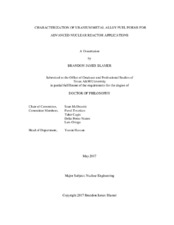| dc.description.abstract | An engineering investigation of the fabrication process for low smear density uranium alloy nuclear fuel forms was completed and the resulting alloys were characterized. The metal fuel alloys investigated in this project were uranium metal, uranium – 5 wt% zirconium (U-5Zr), and uranium – 10 wt% zirconium (U-10Zr). The physical fuel forms of interest included 1) dense, solid rods that could be used be used in low smear density nuclear fuel applications, 2) extruded tubes designed to begin fuel service in constant contact with cladding yet having a low smear density, and 3) low density pellets designed to simulate low density fuel structures.
Extrusion was shown to be an industrially viable option for the production of uranium and U-10Zr rods and tubes. Extrusion experiments were performed in the uranium alpha phase in the temperatures range of 550 to 650°C. The reduction ratio was varied between 4 and 15. The extrusion constant, K, was empirically estimated from the data collected and ranged from 45 to 160 ksi over the course of this study. Larger extrusion ratios as well as higher temperatures resulted in lower extrusion constants.
The microstructures of the extruded products were studied using scanning electron microscopy and neutron diffraction. The specimens exhibited elongated grains in the extrusion direction. The U-10Zr also displayed aligned and elongated α zirconium grains. Neutron diffraction of the U-10Zr product revealed α uranium texture in the (100) and (110) direction as well as δ-UZr2 texture in the (0001) direction. The δ-UZr2 texture was found to persist through high temperature heat treatment, but the α uranium texture did not.
To examine low density porous alloys, U, U-5Zr, and U-10Zr powders were fabricated with a range of densities from ~45 to ~89 %TD. The resulting alloy microstructures were characterized via scanning electron microscopy. The structures of the pellets were typically homogeneous. The microstructures created were similar to the microstructures of fuel that has undergone irradiation swelling.
The porosity-dependent thermal diffusivity of the alloys was measured in the temperatures range of 20 to 300ºC. As sample porosity increased, the diffusivity was observed to decrease linearly over the entire sample set. Diffusivity values for uranium ranged from 10.7 mm^2/s at 88.6 %TD and 300ºC to 2.54 mm^2/s at 46.6 %TD and 30ºC. The empirical relationship between the thermal conductivity and porosity corresponded well with the predicted values from the effective medium theory structural model for modelling the thermal conductivity of two phase materials. | en |


